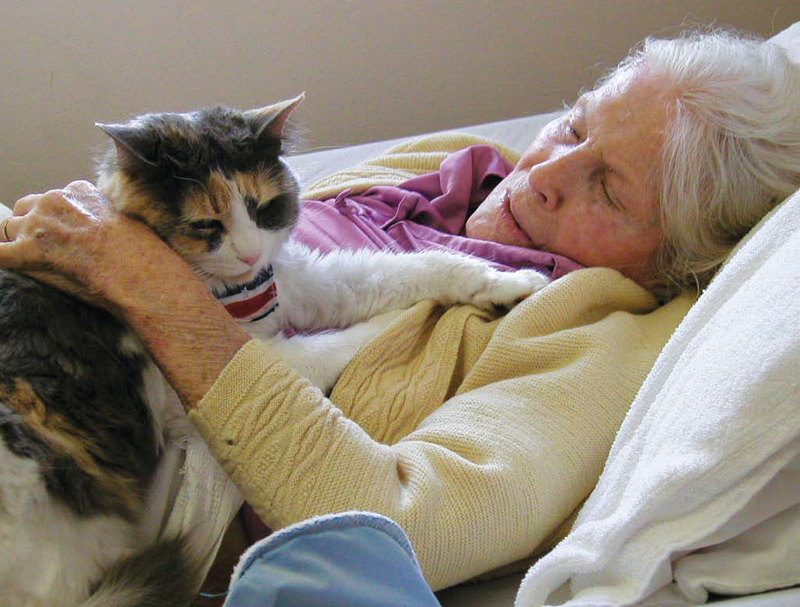Dogs aren’t the only ones that make good therapy animals. Meet some friendly felines who visit hospitals, nursing homes and schools to brighten the lives of seniors, children and patients.
Moorea’s calendar is quite full. Every Monday for the past six years, she has visited the residents of Remington Club Health Center in San Diego. She spends two Thursdays a month at Redwood Terrace visiting seniors, and one Saturday holding court in the lobby or visiting the Alzheimer’s wing at Belmont Village. One Tuesday a month is devoted to making room-to-room visits at Care Meridian, a small ten-bed facility for brain trauma and spinal cord injury patients. “It’s all in a day’s work for a busy therapy cat!” says her person Nancy Denen.
What are therapy cats?
The visits Moorea makes are largely social and called “pet provided therapy”. In this type of therapy, handler and cat visit directly with children, residents or patients. In “pet assisted therapy”, the handler steps back and the cat works with a physical or occupational therapist to restore or improve specific physical abilities in a patient. Stroke patients, for example, might exercise an uncooperative arm by brushing the cat’s fur.
Therapy cats can also help children improve their reading skills. While we humans may jump in to help a child with the pronunciation of a word or tell them to “sound it out”, cats like Ben and Cleo simply put a helping paw on the page. “Cleo’s 14 now,” says her person Michelle Cardosi. “She likes sitting on her pillow and letting the kids come to her, instead of going room to room.” Cleo started doing visits when she was three months old – her early experiences helped her later pass a temperament test to become a certified therapy cat through Love on a Leash.
Make sure your cat is comfortable with car rides, strangers, loud noises, dogs, birds, fish tanks, and furniture like wheelchairs, walkers and IV poles.
Cats on staff
At Levindale Hebrew Geriatric Center and Hospital in Baltimore, Maryland, residents in each unit were asked to decide if they wanted an animal. “We’re part of the Eden Alternative, a philosophy that understands it’s important to give residents the chance to care for other living things,” says Helene King, communications coordinator for the center. “We now have eight cats who live at Levindale. It’s common to walk around a corner and see a cat hanging out in the hallway or in a resident’s room. Our cats also make our employees feel great.”
Even when a cat is thinking about retirement, he might be called back to active duty by popular demand. Take Lucky, a Delta Society cat who recently cut back on his visits. “After all, he’s 17 now,” Elaine Kahn says. “But then we got an email from a woman in the navy. She somehow found out about us on the internet and asked if we could do a few visits to one of her relatives who lives nearby. So I guess it’s time to get Lucky’s vest out again.”
With all the love and petting they receive, therapy cats seem to have it made. Nancy agrees: “After a visit where Moorea has snuggled with so many people, I tease her that I want her job!”
Love on a Leash
Ben was adopted by Rachel Cawley when he was nine years old. Ben is read to twice a month by the students at Valley of Enchantment Elementary School. When not at school, he visits the Mountain Communities Hospital. Rachel says his most touching visit was with a blind woman. “Ben reached out with a paw to get onto her lap. She cuddled him and kissed the top of his head. Other visiting animals had kept their distance and the woman thought they were afraid of her blindness. At our next visit, Ben remembered her.”
Crystal and Jake
Janice Knafla’s Persian cat, Crystal, loves her twice monthly visits to the mental health ward at Sequoia Hospital in Redwood City. Once a month, Crystal also puts on a fashion show and models five or six outfits Janice has made for her. She’s earned five advanced degrees with Love on a Leash – her other visits include schmoozing with fire fighters at the local station house, and visiting the elderly in a nursing home.
Jake, an Abyssinian, has just finished his training and is ready to start doing therapy. He was certified through the Delta Society. Koshka Koh wants to take Jake to visit children with cancer at Dana Farber Hospital. “We met a little girl who was afraid of cats – she was able to pet Jake and was so proud of her accomplishment,” says Koshka. “When we had our assessment, our evaluator said it was like we we’re psychically connected. Even though we haven’t been on an official visit yet, we’re definitely a team.”
Is your cat a candidate ?
If you think your own cat might be a good candidate for therapy work, join an organization such as the Delta Society (www.deltasociety.org) or Love on a Leash (www.loveonaleash.org), both for the training and the liability insurance.
- The most important consideration is temperament. “At our assessment, the woman looked at Jake and said, ‘You know, when it comes to cats, they either hate doing this kind of work, or it’s like they’re born to it,’” says Koshka. “Jake is the second type.”
- Make sure your cat is comfortable with car rides, strangers, loud noises, dogs, birds, fish tanks, and furniture like wheelchairs, walkers, and IV poles.
- Michelle advises using a harness and leash for your cat. Expose her to as many new environments as possible, and start her early in life, if you can.
- Mesh-enclosed strollers are not only good transportation, but they also protect cats from being stepped on or grabbed by over-eager fans. Make sure you’re the only one to lift your cat in and out of the stroller — this is your cat’s quiet spot for a rest between visits, and strange hands reaching in could be scary.
- Don’t worry about being shy or not knowing what to say to a patient or resident. Once you meet a cat lover, you’ll be busy answering questions about your kitty!







No Comment